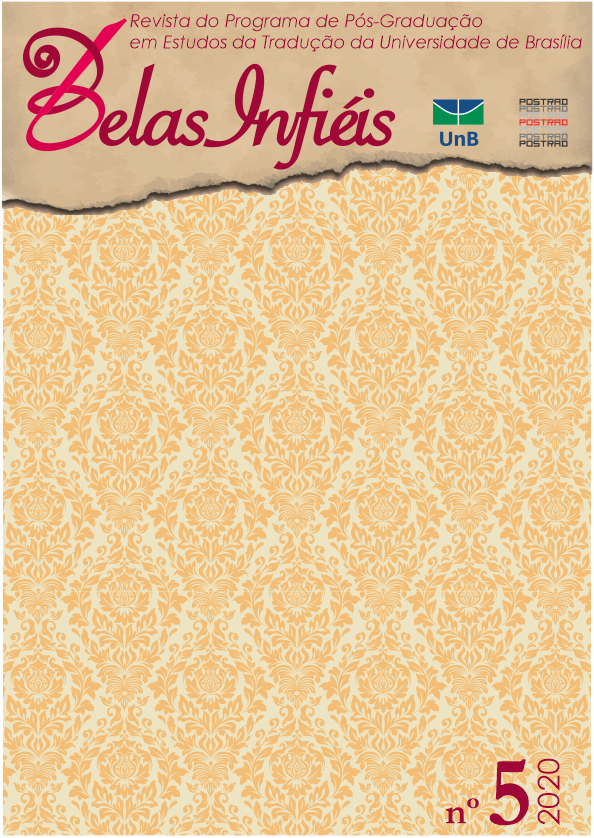Resenha de Translating Picturebooks: Revoicing the Verbal, the Visual, and the Aural for a Child Audience
DOI:
https://doi.org/10.26512/belasinfieis.v9.n5.2020.31975Palabras clave:
Tradução. Livros ilustrados. Literatura infantil. Multimodalidade.Resumen
Esta resenha comenta a obra Translating Picturebooks: Revoicing the Verbal, the Visual, and the Aural for a Child Audience [Traduzindo livros ilustrados: revocalizando o verbal, o visual e o oral para um público infantil], de autoria de Riitta Oittinen, Anne Ketola e Melissa Garavini. A obra trata da tradução de livros ilustrados para crianças, com foco nas peculiaridades das obras ilustradas enquanto entidades multimodais. Abordam-se as implicações da ilustração na prática tradutória e a recepção das traduções por um público que inclui adultos e crianças. A reflexão se insere no âmbito dos estudos da tradução ligados à multimodalidade e à literatura infantil.
Descargas
Citas
BELL, Allan. Language Style as Audience Design. Language in Society 13, p. 145-204, 1984.
BELL, Allan. Back in Style: Reworking Audience Design. In: ECKERT, P. e RICKFORD, J. (org.). Style and Sociolinguistic Variation. New York: Cambridge University Press, 2001, p. 139-169.
BERGER, Arthur Asa. Seeing Is Believing: An Introduction to Visual Communication. London and Toronto: Mayfield Publishing Company, 1998.
BOSCH ANDREU, Emma. Hacia una definición de álbum. Anuario de investigación en literatura infantil y juvenil 5, p. 25-46, 2007.
FRANCO AIXELÁ, Javier. Culture-specific Items in Translation. In: ÁLVAREZ, R. e ÁFRICA VIDAL, M. C. (org.). Translation, Power, Subversion. Clevedon: Multilingual Matters, 1996. p. 52-78.
GILE, Daniel. Integrated Problem and Decision Reporting as a Translator Training Tool. Journal of Specialised Translation 2, p. 2-20, 2004. Disponível em: www.jostrans.org/issue02/art_gile.pdf Acesso em: 09 jun. 2020.
GOLDEN, Seán. Whose Morsel of Lips Will You Bite? Some Reflections on the Role of Prosody and Genre as Non-verbal Elements in the Translation of Poetry. In: POYATOS, F. (org.). Nonverbal Communication and Translation: New Perspectives and Challenges in Literature, Interpretation and the Media. Amsterdam and Philadelphia: John Benjamins Publishing Company, 1997. p. 217-247.
JAKOBSON, Roman. On Linguistic Aspects of Translation. In: BROWER, R. A. (org.). On Translation. New York: Oxford University Press, 1966. p. 232-239.
KRESS, Günther; VAN LEEUWEN, Theo. Reading Images: The Grammar of Visual Design. London and New York: Routledge, 1996.
LEFEVERE, André. Mother Courage’s Cucumbers: Text, System and Refraction in a Theory of Literature. In: VENUTI, L. (org.). The Translation Studies Reader, 3rd ed. London: Routledge, 2012. p. 203-219.
LEWIS, David. Reading Contemporary Picturebooks: Picturing Text. London: Routledge, 2001.
OITTINEN, Riitta. Translating for Children. New York: Garland Publishing, 2000.
O’SULLIVAN, Emer. Comparative Children’s Literature. Translated by Anthea Bell. London and NY: Routledge, 2005. Based on: Kinderliterarische Komparatistik.
PEIRCE, Charles S. Collected Papers by Charles Sanders Peirce. Cambridge: Harvard University Press, 1932.
ROSENBLATT, Louise M. The Reader, the Text, the Poem: The Transactional Theory of the Literary Work. Carbondale and Edwardsville: Southern Illinois University Press, 1978.
SHAVIT, Zohar. Poetics of Children’s Literature. Athens and London: University of Georgia Press, 1986.
TOURY, Gideon. In Search of a Theory of Translation. Tel Aviv: The Porter Institute for Poetics and Semiotics, 1980.
VENUTI, Lawrence. The Translator’s Invisibility: A History of Translation. London: Routledge, 1995.
Descargas
Publicado
Cómo citar
Número
Sección
Licencia
Derechos de autor 2020 CC BY

Esta obra está bajo una licencia internacional Creative Commons Atribución 4.0.
Copyright Statement
Given the public access to this journal, the texts are free to use but requires the recognition of the original authorship and initial publication in this journal to be properly stated.
The journal allows the use of works published for non-commercial purposes, including the right to submit the work to publicly accessible databases. Published contributions are the sole and exclusive responsibility of the author(s).
- When submitting papers to be evaluated by the Belas Infiéis journal, the author(s):
- Declare that the contents of the contributions are original and of their original creation, being entirely responsible for their content if there is an objection by third parties.
- Claim to be aware that they should not commit academic plagiarism.
- Declare that the manuscript has not been published, completely or partially, in Portuguese or another language. If it is a translation it should be submitted to the Translated Articles section.
- Declare that the manuscript is not being evaluated by other journals.
- Declare that the manuscript was not submitted to another journal simultaneously.
- Commit(s) to inform the journal of any kind of error or inaccuracy in their contribution (published, in evaluation or in editing) and to collaborate with the editors to make due corrections of the article (when in evaluation or editing) or erratum/retraction (after publication).
- Declare that there is no conflict of interest regarding the published work.
- Authorize its release if it is accepted for publication without any kind of monetary compensation.
- Agree to assign non-exclusive rights to publication to the magazine, remaining free to make their contribution available in other media as long as the publication of the first version in Belas Infiéis magazine is mentioned. They also authorize Belas Infiéis to assign their texts for reproduction in content indexers, virtual libraries and similar platforms.
- Maintain copyright and grant the journal the right of first publication, the work being licensed under theCreative Commons Attribution License.
- Is/Are allowed and encouraged to publish and distribute their work online after the editorial process, which may increase the impact and citation of the published work.
- Authorize the editorial team to make textual adjustments and to adapt the article to the publication rules, when necessary.



















